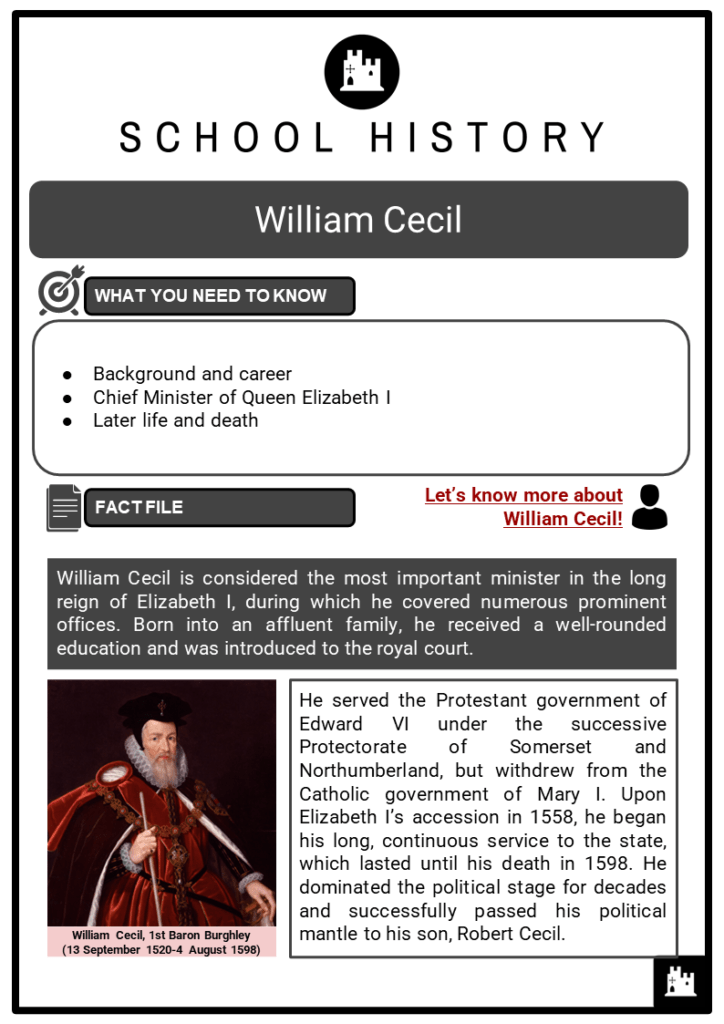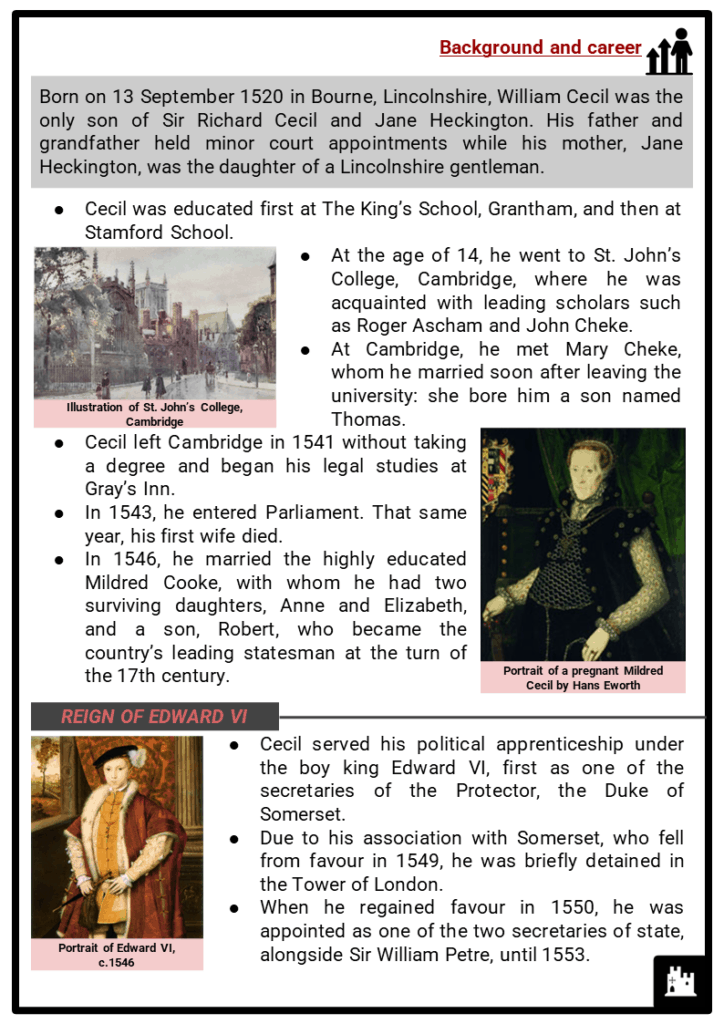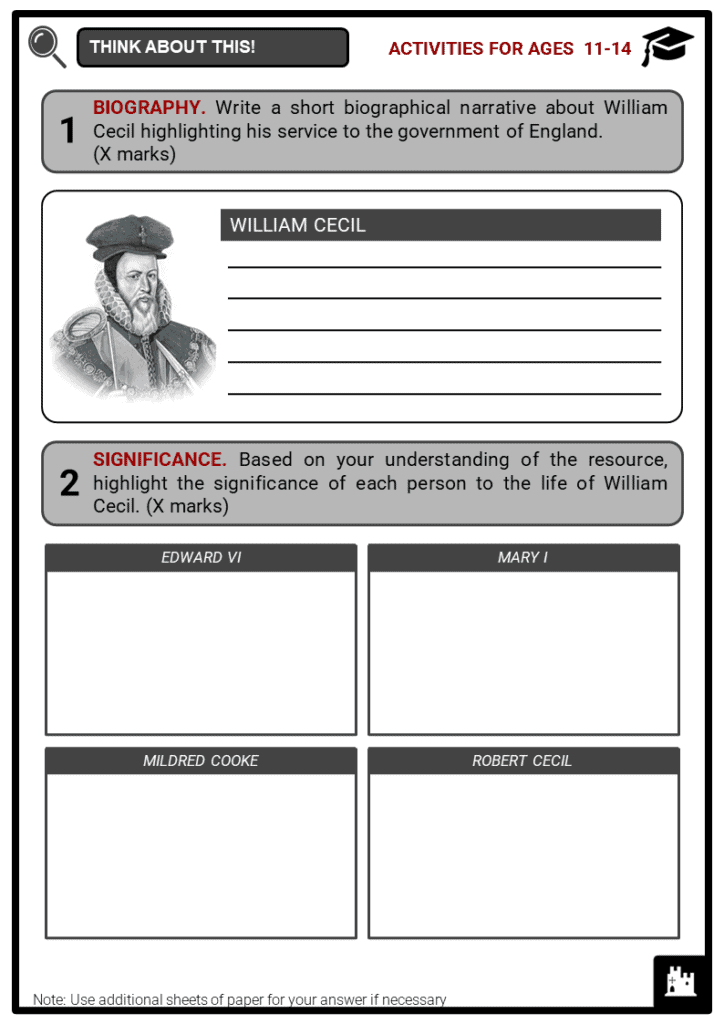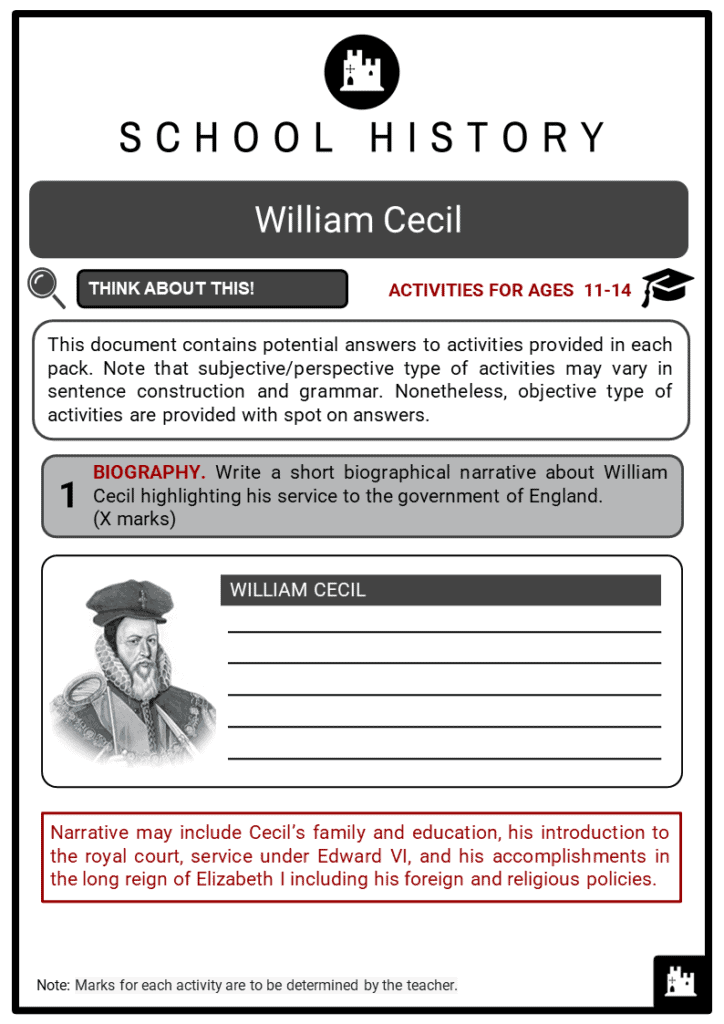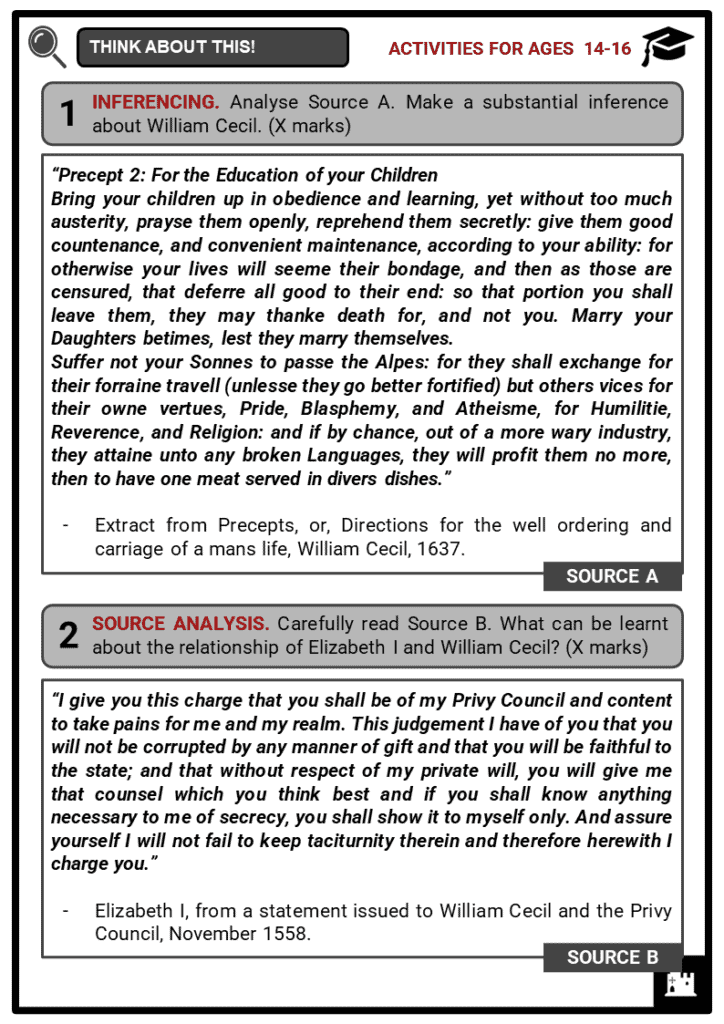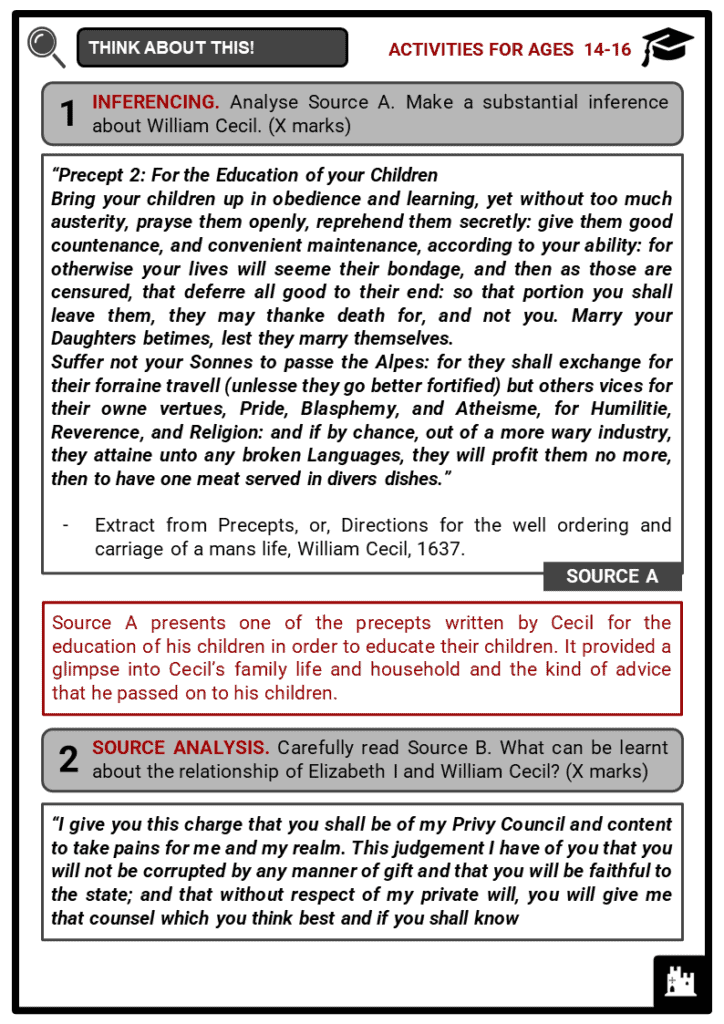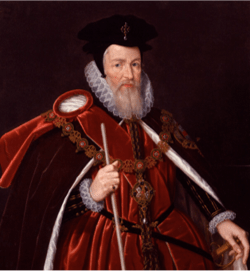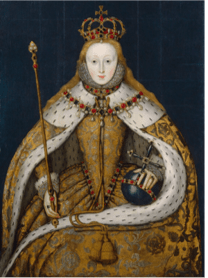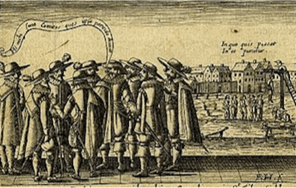Download William Cecil Worksheets
Do you want to save dozens of hours in time? Get your evenings and weekends back? Be able to teach William Cecil to your students?
Our worksheet bundle includes a fact file and printable worksheets and student activities. Perfect for both the classroom and homeschooling!
Table of Contents
Add a header to begin generating the table of contents
Summary
- Background and career
- Chief Minister of Queen Elizabeth I
- Later life and death
Key Facts And Information
Let’s know more about William Cecil!
- William Cecil is considered the most important minister in the long reign of Elizabeth I, during which he covered numerous prominent offices. Born into an affluent family, he received a well-rounded education and was introduced to the royal court.
- He served the Protestant government of Edward VI under the successive Protectorate of Somerset and Northumberland, but withdrew from the Catholic government of Mary I. Upon Elizabeth I’s accession in 1558, he began his long, continuous service to the state, which lasted until his death in 1598. He dominated the political stage for decades and successfully passed his political mantle to his son, Robert Cecil.
Background and career
- Born on 13 September 1520 in Bourne, Lincolnshire, William Cecil was the only son of Sir Richard Cecil and Jane Heckington. His father and grandfather held minor court appointments while his mother, Jane Heckington, was the daughter of a Lincolnshire gentleman.
- Cecil was educated first at The King’s School, Grantham, and then at Stamford School.
- At the age of 14, he went to St. John’s College, Cambridge, where he was acquainted with leading scholars such as Roger Ascham and John Cheke.
- At Cambridge, he met Mary Cheke, whom he married soon after leaving the university: she bore him a son named Thomas.
- Cecil left Cambridge in 1541 without taking a degree and began his legal studies at Gray’s Inn.
- In 1543, he entered Parliament. That same year, his first wife died.
- In 1546, he married the highly educated Mildred Cooke, with whom he had two surviving daughters, Anne and Elizabeth, and a son, Robert, who became the country’s leading statesman at the turn of the 17th century.
- Cecil served his political apprenticeship under the boy king Edward VI, first as one of the secretaries of the Protector, the Duke of Somerset.
- Due to his association with Somerset, who fell from favour in 1549, he was briefly detained in the Tower of London.
- When he regained favour in 1550, he was appointed as one of the two secretaries of state, alongside Sir William Petre, until 1553.
- In 1551, Cecil was knighted by the Earl of Warwick who later became the Duke of Northumberland.
- Although Cecil was loyal to Northumberland, he ultimately sided with the Tudors when Northumberland proposed to alter the succession following Edward VI’s death.
- Upon the accession of Mary I, he was offered employment but decided to withdraw from the Catholic court.
- He was not a radical Protestant and did not hesitate to confirm to the Catholic reaction.
- On occasion, he was able to undertake special duties for the government.
- With Mary I’s death in 1558, Cecil was to become the most important minister in the long reign of Elizabeth I.
Chief Minister of Queen Elizabeth I
- Upon the accession of Elizabeth I, Cecil was sworn in as a minister and thus began his long, continuous service to the state. After his appointment as Secretary of State, he successively held various prominent offices.
- Apart from advising the queen on both domestic and diplomatic affairs as Secretary of State from 1558 to 1572, he also served as Lord Treasurer from 1572 until his death and bore the heavy burden of organising the national finances and working out economic policy.
- Moreover, as Master of the Court of Wards, he dealt with the wardship and marriage of feudal heirs who were under the guardianship of the Crown, as well as with the administration of their estates.
- FOREIGN POLICY
- Cecil was essentially a man of peace, in contrast to his great rival, Robert Dudley, later Earl of Leicester, who favoured more active intervention in European affairs.
- He did, however, favour and organise direct action in Scotland to end the French domination there.
- The Treaty of Edinburgh of 1560, which crowned this successful enterprise, set the framework of Anglo-Scottish relations for the whole reign of Elizabeth I.
- It was also the indispensable preliminary to the eventual union of the two kingdoms.
- In 1565, Cecil’s hopes of further improving Anglo-Scottish relations were threatened by the consequences of Mary, Queen of Scots’ marriage to Lord Darnley.
- RELIGIOUS POLICY
- Cecil grew more Protestant as time on and he shared the queen’s desire to bring the moderate Catholics within an all-embracing Church of England, as directed in the Religious Settlement of 1559.
- But like her, he vigorously attacked the extremists who, he argued, had the political aim of overthrowing the established government of England.
- On the other hand, his desire to ameliorate a lot of the Puritans, who were under heavy pressure to conform to the patterns of the Church of England, was out of keeping with the more hostile attitude of the queen and her archbishop, Whitgift.
- For sharing the queen's enthusiasm to continue the English Reformation, he became a target of a rebellion in the north of England led by the earls of Northumberland and Westmorland.
- The Catholic plotters demanded his removal. However, they were forcefully suppressed.
- Cecil’s counter-intelligence network under the direction of Sir Francis Walsingham successfully intercepted Catholic plots against the queen, particularly the Babington plot that implicated Mary, Queen of Scots.
-
- It was Cecil who brought the long drawn-out crisis over the fate of Mary, Queen of Scots, to an end in 1587 by speedily dispatching the signed execution warrant to forestall a last-minute change of mind by Elizabeth I.
- After the execution, the queen claimed that, though she had signed the warrant, she had forbidden its dispatch until she gave specific instructions.
- For this, Cecil received the full blast of the royal displeasure and, for a time, was forbidden to come to court. But the mood passed, and he came back into her favour.
- When the Spanish Armada was launched in 1587, Cecil’s diplomatic, military, naval and financial preparations were sufficient for defeating the Catholic threat.
- Cecil’s approach was already marked by realistic caution and a deep hostility – generally shared by the queen – towards military adventures.
- That hostility was reinforced by a powerful sense of economy which made him resist any extravagant use of the limited resources of the Exchequer, and here too, he and his monarch marched in step.
- As a mark of her confidence in Cecil, the queen conferred on him the barony of Burghley in 1571.
- Cecil’s policies, taken as a whole, were not marked by radical concepts or original notions. He remained a conservative, concerned much more with making the existing machinery work than with expounding new ideas in government and establishing new organisations for its conduct.
Later life and death
- As Cecil, like the queen, was quickly getting old, he prepared his son Robert to take on his role in the government. Robert obtained the secretaryship in 1596 and took over its responsibilities after Walsingham’s death in 1590.
- Despite his ill health, Cecil continued performing his duties, which were limited to strengthening a programme of retrenchment, supporting campaigns against Spain, and backing the naval expeditions by Francis Drake and Robert Devereux.
- In the last years before his death in London on 4 August 1598, his health was deteriorating and a good deal of his work was handed to Robert.
- Yet, the direction of policy remained in his hands, under the ultimate control of the queen, for whom his passing was an irreparable loss.
- He died at his London residence and was buried in St. Martin’s Church, Stamford.
Image sources:
- https://www.npg.org.uk/collections/search/portrait/mw00919/William-Cecil-1st-Baron-Burghley?LinkID=mp00645&role=sit&rNo=5
- https://www.npg.org.uk/collections/search/portrait/mw02070/Queen-Elizabeth-I
- https://www.thehistorypress.co.uk/articles/a-beginner-s-guide-to-the-babington-plot/

